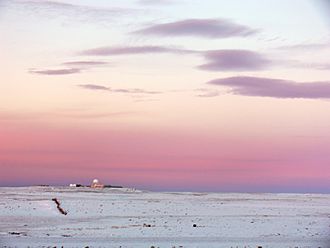Quviasukvik facts for kids
Quick facts for kids Quviasukvikᖁᕕᐊᓲᑎᖃᕐᕕᒃ |
|
|---|---|

The Inuit, Yupik, Aleut, Chukchi and the Iñupiat believed that the sunrise on December 24 marks the beginning of the new year.
|
|
| Also called | Quviasugvik, Inuit New Year, Happy Day, Time of Joy |
| Observed by | Inuit, Yupik, Aleut, Chukchi, Iñupiat, NunatuKavut |
| Type | Cultural (Inuit) Religious (Inuit religion, Shamanist and Christian) |
| Significance | Start of the year and the roaming of the spirits for good luck |
| Celebrations | Watching the first sunrise of the Inuit new year (December 24 only), parades (December 25 only), mass attendance, concerts, carnivals, fairs, Inuit traditional activities, family gathering, family meal, visiting friends and relatives, gift giving, gift shopping, goodwill greetings, late night partying, reflection, watching fireworks (December 31 only), qulliq ceremonies during the first sunrise of the Christian new year (January 1 only), ringing of the first school bell after winter break (January 3 in Greenland; January 4, 5 or 6 only in Canada; January 7 in Russia), flag raising ceremonies (January 7 only) |
| Date | December 24 to January 7 |
| Frequency | Annual |
| Related to | Christmas, Chinese New Year, Japanese New Year, Tibetan New Year, Korean New Year, Vietnamese New Year, Mongolian New Year, Sámi New Year, Yakut New Year |
Quviasukvik (Inuktitut: ᖁᕕᐊᓲᑎᖃᕐᕕᒃ) is a special celebration for the Inuit people. It marks the start of their new year. This important festival is also celebrated by other groups. These include the Yupik, Aleut, Chukchi, and Iñupiat peoples.
Quviasukvik began with old Inuit religion traditions. Over time, it has also taken on some Christian influences. It is a time for joy and new beginnings in the Arctic regions.
Contents
When is Quviasukvik Celebrated?
The Quviasukvik festival starts on Christmas Eve, December 24. It continues until January 7. This long celebration marks the arrival of the new year. It is also a time to honor Sedna, the sea goddess. People believe that spirits move around during this time. This movement brings good luck for the year ahead.
Traditions During the Festival
During Quviasukvik, many traditional customs take place. People gather with their families for meals. They visit friends and relatives. Gift-giving is also a big part of the celebration. There are often parades, concerts, and carnivals. These events bring communities together.
One special tradition is watching the first sunrise. This happens on December 24, the first day of the Inuit new year. On December 31, many people watch fireworks. On January 1, some communities have qulliq ceremonies. A qulliq is a traditional Inuit lamp. These ceremonies welcome the Christian new year.
How Christianity Influenced Quviasukvik
Over time, Christmas became part of the Quviasukvik celebrations. For many Inuit, Christmas is now seen as a new year. This shows how old traditions and new influences can blend. The festival is a mix of ancient beliefs and modern practices.
See Also

